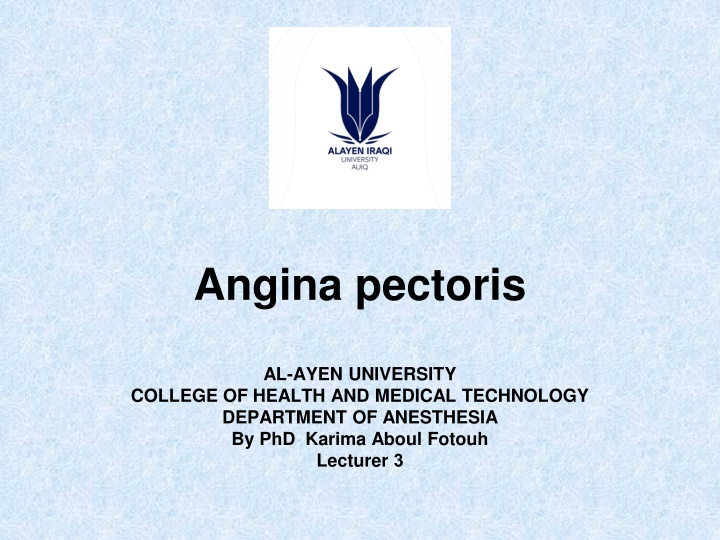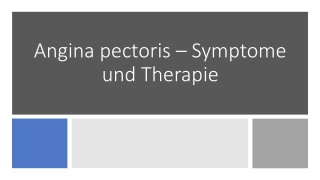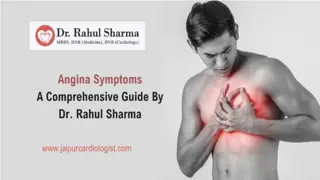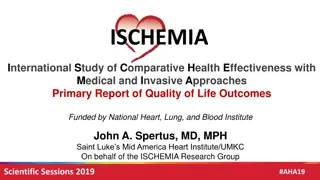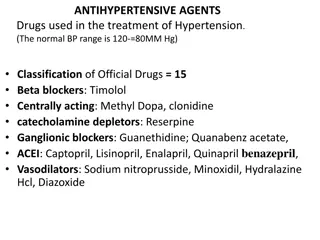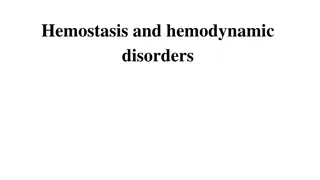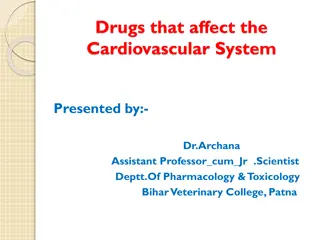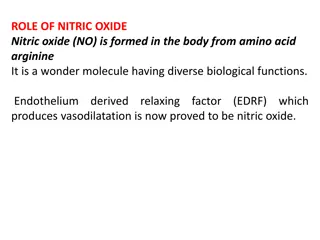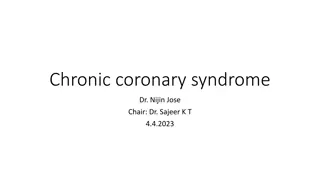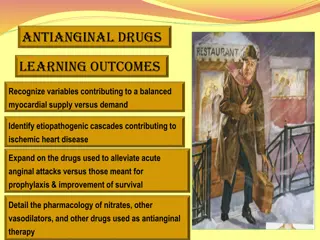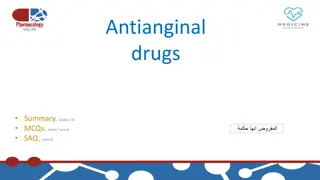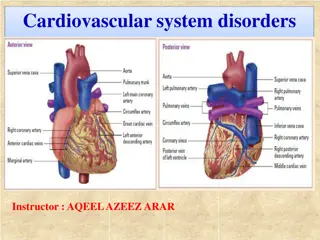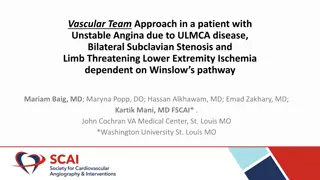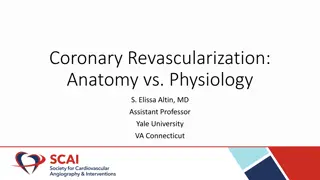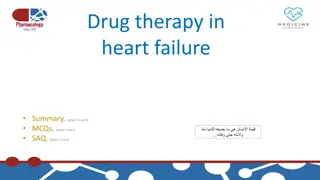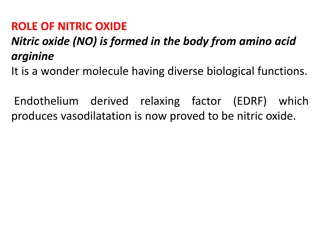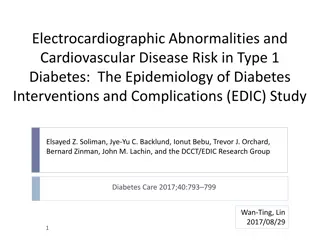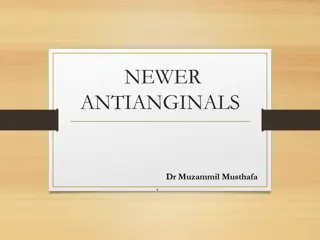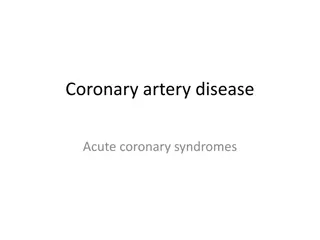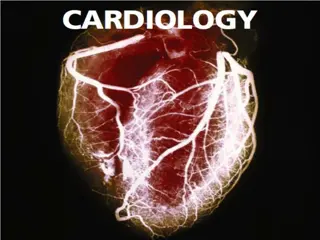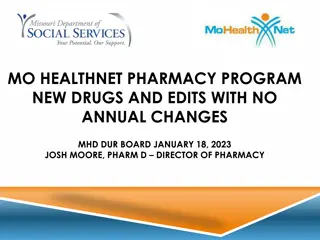Vasodilators in Angina Pectoris Management
Angina pectoris refers to chest pain due to an imbalance between myocardium oxygen demand and supply. Learn about the classification of angina, including stable, unstable, and variant types, and the aim of therapy to improve the balance between oxygen demand and supply. Discover how vasodilators play a crucial role in increasing blood flow to the myocardium and reducing oxygen demand in angina management.
Download Presentation

Please find below an Image/Link to download the presentation.
The content on the website is provided AS IS for your information and personal use only. It may not be sold, licensed, or shared on other websites without obtaining consent from the author.If you encounter any issues during the download, it is possible that the publisher has removed the file from their server.
You are allowed to download the files provided on this website for personal or commercial use, subject to the condition that they are used lawfully. All files are the property of their respective owners.
The content on the website is provided AS IS for your information and personal use only. It may not be sold, licensed, or shared on other websites without obtaining consent from the author.
E N D
Presentation Transcript
Angina pectoris AL-AYEN UNIVERSITY COLLEGE OF HEALTH AND MEDICAL TECHNOLOGY DEPARTMENT OF ANESTHESIA By PhD Karima Aboul Fotouh Lecturer 3
Vasodilators and management of angina pectoris Angina usually refers to angina pectoris. It signifies chest pain and discomfort due to imbalance between myocardium oxygen requirement and oxygen supply by coronary arteries. The pain also can occur in your shoulders, arms, neck, jaw, or back
Classification of angina: Stable (classic, effort) angina: Chest pain brought on when the heart is working harder than usual, such as during exercise. Occurs due to a fixed narrowing of the coronary arteries by atherosclerosis. Symptoms are relieved by rest or medication
Unstable angina (preinfarction angina): Chest pain occurs with less exertion, can occur at rest. Occurs due to disruption of an atherosclerotic plaque with subsequent cascade of platelet activation and aggregation, and thrombosis leading to a decrease in coronary blood flow.
Variant ( prinzmetal's or vasospastic ) angina: Cardiac pain that occurs exclusively at rest. Caused by coronary artery vasospasm (vasospastic) which reduces coronary flow leading to reduction of blood flow to the myocardium.
Aim of Therapy To improve the balance between myocardial oxygen demand and supply. Supply = Demand Coronary Blood Flow Heart rate Contractility Systolic Wall Tension
How to achieve the aim? Increase blood flow to the myocardium by dilating the coronary arteries: Vasodilators (nitrates) and Ca+2channel blockers Decrease oxygen demand by reducing cardiac work: blockers and Ca+2channel blockers Treat coronary artery disease: cholesterol level: statins plaque formation: anticoagulant, antiplatelets aggregation Surgical procedures e.g. stents and angioplasty
Organic nitrates 1. Nitroglycerin ( glyceryl trinitrate ), 2. Isosorbide dinitrate : sublingual, sustained release. 3. Isosorbide mononitrate : oral .
Mechanism of action : to produce relaxation of smooth muscles esp. B.V.(artery and veins more than arterioles) .
Pharmacological actions : V.D. of blood vessels and decreased B.P. Reflex sympathetic stimulation tachycardia and stimulate respiration reflexly . Relax other smooth muscles as bronchi, gut and urinary . It decrease platelets aggregations
Therapeutic uses : 1) Angina pectoris ( all types ) : Acute attack by nitroglycerin or isosorbide dinitrate sublingual or oral spray . Prophylaxis by long acting nitrates oral, sublingual or ointment . IV nitroglycerin is restricted to the treatment of severe, recurrent rest angina. 2) Congestive heart failure. 3) Myocardial infarction 4) In cyanide poisoning
II. Slow calcium channel blockers (Calcium influx inhibitors) Classification : Dihydropyridines : nifedipine, amlodipine nitrendipine, nimodipine and nicardipine Miscellaneous verapamil, diltiazem, and bepridil . Verapamil and diltiazem affect heart more than vessels while nifedipine, nimodipine and nicardipine affect vessels more than heart .
Mechanism and actions : Block the voltage sensitive calcium channel They relax vascular smooth muscles so: They decrease peripheral and coronary resistance ( nifedipine). myocardial contractile force myocardial O2requirements (verapamil, diltiazem ). NB Verapamil, diltiazem Bradycardia Nifedipine reflex tachycardia.
Verapamil : It affects cardiac tissue more than vascular smooth muscles, so it decreases B.P., H.R.,COP It blocks alpha-receptors also . Uses : Antiarrhythmic in supraventricular arrhythmia (class IV) Prophylactic treatment of all types of angina. Hypertension . Prophylaxis of migraine headache. Adverse effects : Bradycardia, heart block, heart failure, hypotension, flushing, ankle edema and constipation .
III . Beta-adrenoreceptor blockers They decrease H.R., and contractility, so decrease the myocardial work and myocardial oxygen consumption especially during exercise. They are used for prophylaxis of angina pectoris associated with effort but not in variant angina .
Prophylactic treatment : 1) Variant angina : Nitrates orally, transdermal forms or nifedipine orally . If no response give nitrate + verapamil or diltiazem . Nitrate + nifedipine ( in severe cases or if verapamil or diltiazem are contraindicated ) . This combination may produce hypotension and tachycardia. 2) Stable (effort) angina : Nitrate + beta-blocker aspirin Nitrate + verapamil or diltiazem + to inhibit Nifedipine + -blocker aggregation 3) Unstable angina : I.V. heparin + antiplatelet drugs + nitrates + nifedipine + -blocker .
